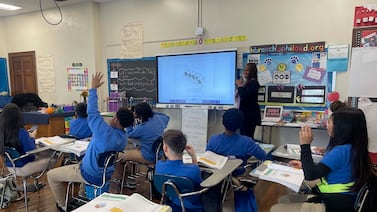Sign up for Chalkbeat Indiana’s free daily newsletter to keep up with Indianapolis Public Schools, Marion County’s township districts, and statewide education news.
Around one-third of the 186,000 middle schoolers tested in Indiana in the 2024-25 school year did not read at grade level, according to data from the Department of Education presented Wednesday.
To improve reading proficiency for sixth through eighth graders, the department will seek outside contractors to work with middle schools on reading interventions as part of a pilot program.
The data follows this summer’s state testing scores, which showed that English language arts proficiency declined for middle schools, even as younger students improved in ELA and reading.
To begin addressing the issue, the state wants to bring in vendors for “outcomes-based contracting,” or a contract in which they would be paid for improving literacy in grades 6-8.
The state is seeking philanthropic donations to supplement state funding for the pilot program, which middle schools would be able to opt into, said Secretary of Education Katie Jenner.
“The only way to turn the curve is to address head-on the area where we see that slide,” said Jenner.
Officials did not say on Wednesday how much state funding is available for the program or how many schools can participate.
Middle schoolers’ reading proficiency data was collected as part of the state’s ILEARN checkpoint pilot, which broke the state test into sections throughout the year for schools that chose to participate. By the second checkpoint in 2024-25, 42% of students in grades 6-8 were not reading at grade level as measured by their Lexile scores, which are calculated based on the students’ reading ability and the difficulty of a text, officials said.
By the end-of-year summative test, around 31% still did not read at grade level.
In contrast, around 13% of third graders were not proficient in reading as measured by the third grade reading test, the IREAD. Officials pointed to the IREAD results, which improved significantly this year, as a sign that the state’s recent efforts to improve early literacy are paying off.
One caveat: The middle school numbers represent only around 75% of schools in Indiana, and will likely change after this year, when all schools are required to administer the ILEARN in sections.
Aleksandra Appleton covers Indiana education policy and writes about K-12 schools across the state. Contact her at aappleton@chalkbeat.org.







